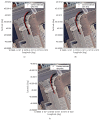Infrastructure-Based Vehicle Localization through Camera Calibration for I2V Communication Warning
- PMID: 37631673
- PMCID: PMC10457856
- DOI: 10.3390/s23167136
Infrastructure-Based Vehicle Localization through Camera Calibration for I2V Communication Warning
Abstract
In recent years, the research on object detection and tracking is becoming important for the development of advanced driving assistance systems (ADASs) and connected autonomous vehicles (CAVs) aiming to improve safety for all road users involved. Intersections, especially in urban scenarios, represent the portion of the road where the most relevant accidents take place; therefore, this work proposes an I2V warning system able to detect and track vehicles occupying the intersection and representing an obstacle for other incoming vehicles. This work presents a localization algorithm based on image detection and tracking by a single camera installed on a roadside unit (RSU). The vehicle position in the global reference frame is obtained thanks to a sequence of linear transformations utilizing intrinsic camera parameters, camera height, and pitch angle to obtain the vehicle's distance from the camera and, thus, its global latitude and longitude. The study brings an experimental analysis of both the localization accuracy, with an average error of 0.62 m, and detection reliability in terms of false positive (1.9%) and missed detection (3.6%) rates.
Keywords: I2V communication; image detection; intelligent transportation system; road user localization; roadside unit.
Conflict of interest statement
The authors declare no conflict of interest.
Figures

















References
-
- Buch N., Velastin S.A., Orwell J. A review of computer vision techniques for the analysis of urban traffic. IEEE Trans. Intell. Transp. Syst. 2011;12:920–939. doi: 10.1109/TITS.2011.2119372. - DOI
-
- Tyagi B., Nigam S., Singh R. A Review of Deep Learning Techniques for Crowd Behavior Analysis. Arch. Comput. Methods Eng. 2022;29:5427–5455. doi: 10.1007/s11831-022-09772-1. - DOI
-
- Ounoughi C., Yahia S.B. Data fusion for ITS: A systematic literature review. Inf. Fusion. 2023;89:267–291. doi: 10.1016/j.inffus.2022.08.016. - DOI
-
- Nidamanuri J., Nibhanupudi C., Assfalg R., Venkataraman H. A Progressive Review: Emerging Technologies for ADAS Driven Solutions. IEEE Trans. Intell. Veh. 2022;7:326–341. doi: 10.1109/TIV.2021.3122898. - DOI
-
- Hu L., Ou J., Huang J., Chen Y., Cao D. A Review of Research on Traffic Conflicts Based on Intelligent Vehicles. IEEE Access. 2020;8:24471–24483. doi: 10.1109/ACCESS.2020.2970164. - DOI
LinkOut - more resources
Full Text Sources

